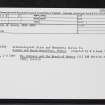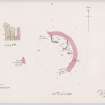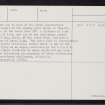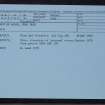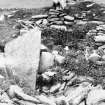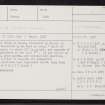Sanday, Broch Of Wasso, Tres Ness
Broch (Iron Age)(Possible)
Site Name Sanday, Broch Of Wasso, Tres Ness
Classification Broch (Iron Age)(Possible)
Alternative Name(s) Tresness
Canmore ID 3564
Site Number HY73NW 2
NGR HY 70919 37943
Datum OSGB36 - NGR
Permalink http://canmore.org.uk/site/3564
- Council Orkney Islands
- Parish Lady
- Former Region Orkney Islands Area
- Former District Orkney
- Former County Orkney
HY73NW 2 7092 3794.
(HY 7092 3794) Wasso (NR)
OS 6" map, Orkney, 2nd ed., (1900).
The Broch of Wasso, excavated by Dryden in 1868 (H Dryden, folio 1 B1 1879), and described by Dr Wood as being built of large flat stones, is about 15' in height, and upwards of 180' in circumference at the base (From a letter by Dr Wood to OS). It now exists as a stony mound, grass-grown, and extensively quarried, with nothing visible to suggest its character. A polished bone implement 4 1/2ins. long from 'Wasshow' is in NMAS (GA8).
New Statistical Account (NSA) 1845; National Museum of Antiquities of Scotland (NMAS) 1892; RCAHMS 1946, visited 1928.
All that can be seen of the broch construction towards the summit of the mound, still known as "Wasso", is the N arc of the inner face for a distance of 2.5m and a height of 1.1m, and one or two contiguous stones also in the N arc, which, if the outer face, indicate a wall thickness of about 4.4m. The inner face is incorporated in a crude, recent structure, within which is one of the large slabs lying at an angle, mentioned by the RCAHMS. The mound is about 60.0m N-S by about 44.0m E-W and 5.0m high,its size indicating the presence of other structures, probably a post-broch settlement, within it.
Re-surveyed at 1/2500.
Visited by OS (NKB) 14 July 1970.
Note (1980)
Wasso, Sanday HY 7092 3794 HY73NW 2
Large broch mound with some wall-face and slabs showing.
RCAHMS 1980
(NSA, xv, Orkney, 136; Petrie notebook 9, pp. 80-3, 101; plan in NMRS; RCAHMS 1946, ii, p. 166, No. 438; OR 150)
Field Visit (1999)
A massive grassy mound, 5m in height, marks the site of a broch. It surmounts a natural knoll, set within a marshy area between a small loch and the sea. Partial antiquarian investigations were carried out in the late 1800's, probably by Farrar, and the site was briefly noted by both Petrie and later by Dryden. The mound and surrounding platform, which are very overgrown, cover an area some 80m in diameter. Little of the actual broch structure is now visible, although some stonework is exposed to the north side of the mound. The scale of the mound strongly suggests the presence of extra-broch settlement; there are also indications of an surrounding enclosure bank. It should be noted that the waterlogged conditions in the local area may have important implications for the survival of organic materials within the archaeological deposits. Ref.: NSA (1845) Vol 15, 136; NMAS (1892) ' Catalogue of the National Museum of Antiquaries of Scotland' new ed., 228; Dryden, H (1879), 'Orkney and Shetland circles, broughs & etc: plans', Soc Antiq Scot Mss 170; Petrie, G (1890) 'Notice of the brochs or large round towers of Orkney' in Arch Scotica, 5 (1874-1890), 71-94; Petrie, G, Ms Notebook 9, Soc Antiq Scot Mss 554; RCAHMS (1946) #438; RCAHMS (1980) # 67; Hedges, J W (1987) 'Bu, Gurness and the brochs of Orkney' part 3, #43.
Coastal Zone Assessment Survey, 1999
Publication Account (2002)
HY73 2 WASSO ('Wasshow', 'Wassa')
HY/70923794
Probable broch in Lady parish on Sanday, standing on the long promontory of Tresness. Now a grass-grown mound about 4.58 m (15 ft.) high it was James Farrer [2], not Sir H Dryden [4], who explored the mound in 1868; Dryden's sketch plan, made from Petries' notes, survives as the only record [2, fig. 256]. This shows the NE quarter of the inner face of what looks like a broch, with a number of stone slabs set upright in the enclosed floor close to it; some of these are shown with a height of 4.12 m (13 ft. 6 in.). The information about the size of the structures does not seem reliable [4].
One pointed bone implement, a stone whorl and some potsherds from the site are in the National Museum in Edinburgh.
Sources: 1. OS card HY 73 NW 2: 2. Petrie 1890, 94: 3. RCAHMS 1946, 2, 166, no. 438 and fig. 256: 4. Hedges et al. 1987, 118-19: Lamb 1980, 16.
E W MacKie 2002












